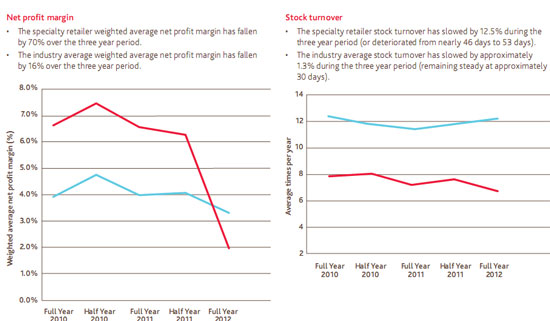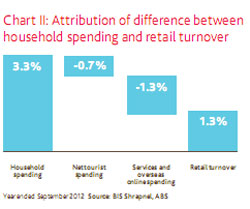(Just in case you hadn’t noticed), rising expenses are cutting into retail profits in specialty retailing, according to an in-depth report from BDO and BIS Shrapnel, moving retail giants Wesfarmers and Woolworths further in front in terms of profitability.
The inaugural ‘Spend Trend’ report, prepared for share investors, examined 18 ASX-listed specialty retailers and found that while retail turnover and margins have remained relatively flat, expenses are rising as a percentage of sales, which has led to a drop in net profit margins of 70 per cent over the past three years.

However, when the two diversified grocer/mass merchants Wesfarmers and Woolworrths are included as well, the drop in net profits overall is just 16 percent (underscoring the value of being part of a duopoly!).
According to John Bresolin, a partner at BDO, high fixed costs such as rent and salaries, coupled with asset write downs and a significantly increased marketing spend have cut into the specialists’ profits.
‘Controlling fixed expenses is among the biggest challenges faced by retailers. For specialty retailers, aggregated salaries, wages, rent and marketing expenses as a percentage of sales increased from nearly 34 per cent in financial year 2010 to 41 per cent in financial year 2012,’ he said.
‘The major increase was as a result of marketing and selling expenses which, when expressed as a percentage of sales, increased by 70 per cent over the three year period.
‘So while looking to keep employee and rental costs under control, marketing spend has increased significantly as retailers compete for market share, which has significantly impacted retailers’ profits, given the relatively flat revenue levels.
‘Wesfarmers and Woolworths have withstood the economic pressures better than specialty retailers thanks to their diversity and presence in commodity product areas, namely food, beverage and petrol,’ said Mr Bresolin.
‘However, specialty retailers have suffered far more due to the discretionary nature of their business. While people will always need to buy groceries, alcohol and fuel, occasional high-value discretionary purchases like televisions, whitegoods, fashion items, etc, can either slip off their shopping list or can be more easily sourced through the multitude of overseas websites, invariably at a significant discount.’
Spending up, but leaking offshore

Despite the difficult economic environment, Australian household spending is increasing, albeit at a faster rate than retail revenue – as a proportion of this is heading offshore.
The high Australian dollar is a further encouragement for Australians to purchase from overseas, and for tourists to reduce trips to Australia and watch the pennies while they are here.
Despite the dwindling profit margins, increased gearing and reducing stock turnover, many retailers haven’t reduced the rate at which they pay their creditors.
Mr Bresolin noted that despite the fact the retail sector’s average gearing levels have increased significantly over the last three years, they remain at reasonable levels when compared to many other industry sectors, but once again the presence of Wesfarmers and Woolworths skews the figures.
‘The average gearing level for the retail sector in Australia is around 30 per cent. While this is no cause for alarm, the trend in gearing levels is rising. For example, specialty retailer gearing ratios increased by more than 60 percent over the three year period,’ he said.
To access the 16-page BDO Spend Trend report as a PDF, click here.





Be First to Comment